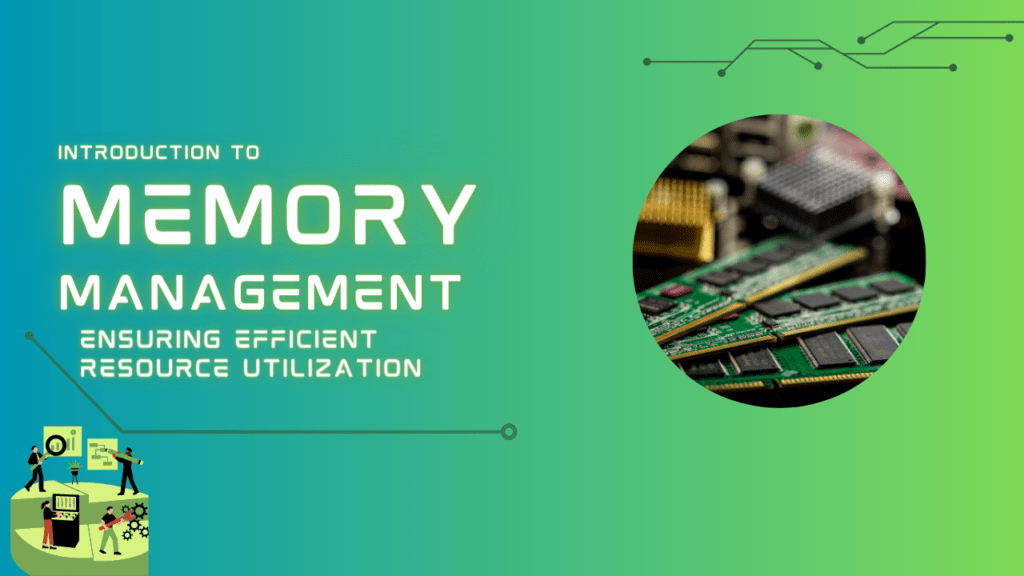What is Memory Management?
In operating systems, memory management is the process of coordinating and controlling computer memory, ensuring that each process or application receives the required amount of memory to function correctly. It involves various tasks, such as memory allocation, protection, de-allocation, and addressing.
Memory Allocation Techniques
Memory can be allocated to processes using different techniques, depending on the requirements of the operating system and the applications it runs:
Single Contiguous Allocation
In this technique, the entire memory is treated as a single block, and processes are allocated memory contiguously. While simple, it can lead to memory fragmentation and inefficient resource utilization.
Partitioned Allocation
Memory is divided into fixed-size partitions, and each partition can hold one process. This technique reduces fragmentation but may lead to inefficient memory use, especially if processes have varying memory requirements.
Paging
Paging divides memory and processes into fixed-size blocks called pages. This allows for non-contiguous allocation, reducing fragmentation and offering more flexibility in memory allocation.
Segmentation
In segmentation, memory is divided into variable-sized segments, each representing a logical unit of a process. This allows for more efficient memory utilization and supports dynamic memory requirements.
Virtual Memory
Virtual memory is a memory management technique that allows a process to use more memory than is physically available. It utilizes disk space as an extension of physical memory, facilitating the execution of more extensive programs.
Memory Management Unit (MMU)
The Memory Management Unit (MMU) is a hardware component responsible for translating virtual addresses used by a process into physical addresses in memory. It enables virtual memory and helps maintain memory protection.
Memory Protection
Memory protection is a critical aspect of memory management that prevents one process from accessing the memory space assigned to another. It ensures the integrity and security of each process’s memory.
Memory De-allocation
When a process terminates, or releases memory, the memory space it occupies must be de-allocated and made available for other processes. Proper memory de-allocation prevents memory leaks and maximizes resource utilization.
Memory Fragmentation
Memory fragmentation occurs when free memory becomes scattered into small, non-contiguous blocks, reducing the amount of usable memory. Fragmentation can degrade system performance and efficiency.
Memory Management Algorithms
To efficiently allocate memory to processes, various algorithms are used:
First-Fit
The first-fit algorithm allocates the first available memory block large enough to accommodate a process.
Best-Fit
The best-fit algorithm allocates the smallest available memory block to hold the process, minimizing wastage.
Worst-Fit
The worst-fit algorithm allocates the most significant available memory block, leaving smaller fragments for future use.
Challenges in Memory Management
Memory management faces several challenges:
Thrashing
Thrashing occurs when the system spends more time swapping pages between main memory and disk, resulting in poor performance.
Page Faults
Page faults happen when a process tries to access a page not in the main memory, leading to slower execution.
Conclusion
Memory management is a critical function in modern operating systems, ensuring efficient utilization of memory resources and smooth execution of processes. By employing various memory allocation techniques, addressing memory protection, handling fragmentation, and implementing memory management algorithms, operating systems can deliver optimal performance and enhance the user experience. Understanding the intricacies of memory management helps developers design robust and scalable systems that can handle diverse computing demands.
F.A.Q.s
What is memory management in operating systems?
Memory management in operating systems refers to efficiently handling computer memory, allocating resources to processes, and ensuring optimal performance.
What are the standard memory allocation techniques?
Standard memory allocation techniques include single contiguous allocation, partitioned allocation, paging, segmentation, and virtual memory.
What is a Memory Management Unit (MMU)?
The Memory Management Unit (MMU) is a hardware component that translates virtual addresses to physical addresses, enabling virtual memory and memory protection.
What challenges does memory management face? Memory management faces challenges such as thrashing, where the system spends excessive time swapping pages, and page faults, which result in slower execution.



